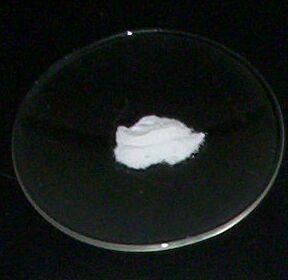 | ||
A watch glass is a circular concave piece of glass used in chemistry as a surface to evaporate a liquid, to hold solids while being weighed, for heating a small amount of substance and as a cover for a beaker. The latter use is generally applied to prevent dust or other particles entering the beaker; the watch glass does not completely seal the beaker, so gas exchanges still occur. Its name is due to its similarity to those glasses wherewith old pocket watches were protected.
Contents
When used as an evaporation surface, a watch glass allows closer observation of precipitates or crystallization, and can be placed on a surface of contrasting color to improve the visibility overall.
Watch glasses are also sometimes used to cover a glass of whisky, to concentrate the aromas in the glass, and to prevent spills when the whisky is swirled.
Watch glasses are named so because they are similar to the glass used for the front of old-fashioned pocket watches. In reference to this, large watch glasses are occasionally known as clock glasses.
Uses
One of the generic uses of a watch glass as mentioned previously includes as a lid for beakers. In this case a watch glass is placed above the container, which makes it easier to control and alter vapour saturation conditions. Moreover, a watch glass is often used to house solids being weighed on the scale. Prior to weighing desired amount of solid, a watch glass is placed on the scale, followed by taring or zeroing the scale so that only the weight of the sample substance is obtained.
Not only can a watch glass be used for observing precipitation patterns and crystals, it can also be used for drying solids. When further drying is required, a watch glass is often used in cases where a particular type of solid needs to be separated from its comparatively volatile solvent. The solid is spread on a watch glass and, often time, a folded filter paper is placed above to keep out airborne particles from contaminating the product.
To maximize the drying rate, a watch glass can be placed inside a fume hood to provide good air circulation for a adequate amount of time. Another technique used in chemistry laboratories to increase the drying rate is passing a gentle stream of dry air or nitrogen gas over the watch glass from an inverted funnel clamped above it.
Types
There are two types, Glass watch glasses and Plastic watch glasses used in the laboratory. These watch-glasses are available in various sizes and widths. Watch-glass are usually thicker than any other glass or plastic lab-ware.
Common Glasses
Three typical materials used to make watch-glass, as these materials are the transparent covering over the face:
- Acrylic Crystal - It is the same material as a plastic and it is transparent, strong and versatile. These are not very scratch resistant as it produces good results without costing a lot, but these scratches can be removed under certain processes.
- Mineral Crystal - Ordinary glass are treated by using heat or chemicals to make it more resistant to scratches. Moreover, If there is too many scratches then it has to be replaced as this could result in the breakage of the glass.
- Sapphire Crystal - There are two types of sapphire crystals that most watch-glass are made up of, either the original sapphire or the synthetic sapphire. It costs more than the other two crystals, but it is long-lasting and does not shatter or get scratched easily.
